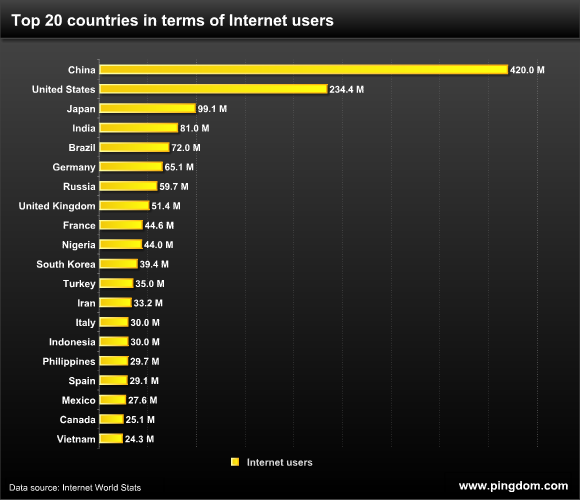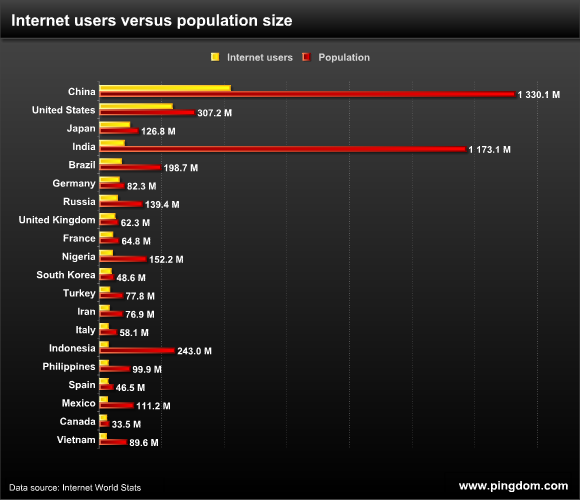 The world is a big place, but so is the Internet. We know which countries are the largest in the real world, but what about on the Internet?
The world is a big place, but so is the Internet. We know which countries are the largest in the real world, but what about on the Internet?
This article examines which countries are the largest in terms of Internet users, and also looks into their growth potential. That last point is very interesting to look at because it’s an indication of how the power balance on the Internet might shift in the future.
But before we head on to the charts, let’s start with a few interesting findings.
Observations on Internet usage
Here are some standout facts and observations that give additional perspective to the Internet usage of the top countries on the Internet.
- There are a total of 1.8 billion Internet users in the world.
- There are 32 countries with more than 10 million Internet users.
- The top 10 countries on the Internet together have 1.17 billion Internet users. That’s 65% of all Internet users in the world.
- The top 20 countries on the Internet together have 1.47 billion Internet users. That’s just under 82% of all Internet users.
- India is the fourth largest country in terms of Internet users in spite of having an Internet penetration of a measly 6.9%. This thanks to its huge population.
- China takes the top spot both in terms of population and Internet users. China has almost twice (1.8x) as many Internet users as the United States.
- China together with the United States, the top two countries, make up half of the Internet users in the top 15.
- Out of the top 20 countries, the five with the highest Internet penetration (not users) are: United Kingdom (82.5%), South Korea (81.1%), Germany (79.1%), Japan (78.2%), United States (76.3%).
By Internet penetration, we mean the share of the population made up of Internet users.
Top countries in terms of Internet users
The Internet is almost like its own world, so when you’re thinking about what countries are the largest in that world, it makes sense to count Internet users instead of real-world population.

Not only is China the largest in terms of real-world population, the country also has by far the largest number of Internet users. This may not come as a huge surprise, but looking past the absolute top of the list, there are some countries that may be unexpected residents in the top 20.
A few additional observations:
- The tenth largest country on the Internet is Nigeria. So although Africa as a whole is often considered to be a bit behind the curve on the Internet, it does have a presence among the top countries.
- Seven out of the top 20 countries are Asian (35%).
- Five out of the top 20 countries are European (25%). Six (30%) if you also count Russia.
- Three of the top 20 are English-language countries (four if you count India).
Internet users versus country populations
We thought it would be interesting to show you the number of Internet users these countries have in relation to their actual population size. The below chart clearly shows how much the Internet penetration differs between countries.
Why even look at this? One word: potential.
This chart identifies which of these countries have a lot of growth potential on the Internet, and which don’t.

Note: This chart is still sorted by Internet users, so it has the same order as the previous chart.
Countries where Internet users make up a minority of the population have a larger growth potential than countries where Internet users are in majority. This has big implications for the future.
Many of the more developed nations already have a high Internet penetration, having already converted most of their population to Internet users. Look at the United States, Japan, Germany, the United Kingdom, and so on. Their size on the Internet has little room for growth.
But look at countries like India, China, Brazil, Vietnam, the Philippines, Russia. As the Internet penetration in these countries rise, the balance of power on the Internet will start to shift.
In five to ten years, the order in the top 20 list will be quite different.
Final words
The Internet is a truly global phenomenon (which probably hasn’t escaped anyone), so it’s nice to see countries from all parts of the world in the top 20 we presented here.
We hope we have given you some insight into what the Internet of today looks like in terms of Internet users and nationalities, and hopefully also some food for thought about the future.
Data source for Internet and population numbers: Internet World Stats



























